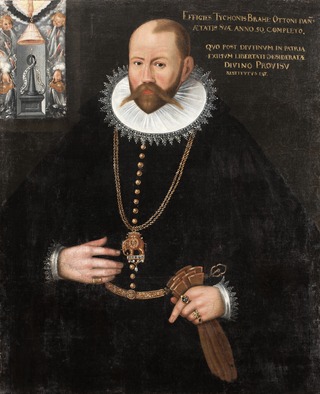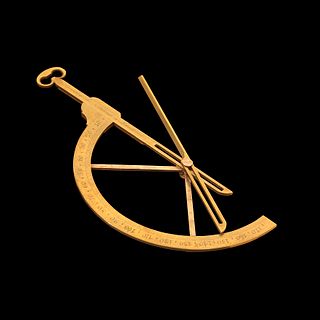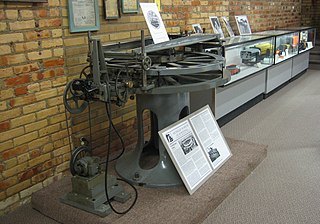
Tycho Brahe, generally called Tycho for short, was a Danish astronomer, known for his comprehensive and unprecedentedly accurate astronomical observations. He was known during his lifetime as an astronomer, astrologer, and alchemist. He was the last major astronomer before the invention of the telescope.

A vernier scale, named after Pierre Vernier, is a visual aid to take an accurate measurement reading between two graduation markings on a linear scale by using mechanical interpolation, thereby increasing resolution and reducing measurement uncertainty by using vernier acuity to reduce human estimation error. It may be found on many types of instrument measuring linear or angular quantities, but in particular on a vernier caliper which measures internal or external diameter of hollow cylinders.

Stjerneborg was Tycho Brahe's underground observatory next to his palace-observatory Uraniborg, located on the island of Hven in the Øresund between Denmark and Sweden.

Pedro Nunes was a Portuguese mathematician, cosmographer, and professor, probably from a New Christian family.

Uraniborg was a Danish astronomical observatory and alchemy laboratory established and operated by Tycho Brahe. It was the first custom-built observatory in modern Europe, and the last to be built without a telescope as its primary instrument.

An alidade or a turning board is a device that allows one to sight a distant object and use the line of sight to perform a task. This task can be, for example, to triangulate a scale map on site using a plane table drawing of intersecting lines in the direction of the object from two or more points or to measure the angle and horizontal distance to the object from some reference point's polar measurement. Angles measured can be horizontal, vertical or in any chosen plane.

Pierre Vernier was a French mathematician and instrument inventor. He was the inventor and eponym of the vernier scale used in measuring devices.

A goniometer is an instrument that either measures an angle or allows an object to be rotated to a precise angular position. The term goniometry derives from two Greek words, γωνία (gōnía) 'angle' and μέτρον (métron) 'measure'. The protractor is a commonly used type in the fields of mechanics, engineering, and geometry.
The backstaff is a navigational instrument that was used to measure the altitude of a celestial body, in particular the Sun or Moon. When observing the Sun, users kept the Sun to their back and observed the shadow cast by the upper vane on a horizon vane. It was invented by the English navigator John Davis, who described it in his book Seaman's Secrets in 1594.

Caliper(s) or calliper(s) are an instrument used to measure the dimensions of an object; namely, the diameter or depth of a hole. The least count of vernier caliper is 0.1mm

The octant, also called a reflecting quadrant, is a reflecting instrument used in navigation.

Stadiametric rangefinding, or the stadia method, is a technique of measuring distances with a telescopic instrument. The term stadia comes from a Greek unit of length Stadion which was the typical length of a sports stadium of the time. Stadiametric rangefinding is used for surveying and in the telescopic sights of firearms, artillery pieces, or tank guns, as well as some binoculars and other optics. It is still widely used in long-range military sniping, but in many professional applications it is being replaced with microwave, infrared, or laser rangefinding methods. Although much easier to use, electronic rangefinders can give away the shooter's position to a well-equipped adversary, and the need for accurate range estimation existed for much longer than electronic rangefinders small and rugged enough to be suitable for military use.
In astronomy, sextants are devices depicting a sixth of a circle, used primarily for measuring the position of stars. There are two types of astronomical sextants, mural instruments and frame-based instruments.

A mural instrument is an angle measuring instrument mounted on or built into a wall. For astronomical purposes, these walls were oriented so they lie precisely on the meridian. A mural instrument that measured angles from 0 to 90 degrees was called a mural quadrant. They were utilized as astronomical devices in ancient Egypt and ancient Greece. Edmond Halley, due to the lack of an assistant and only one vertical wire in his transit, confined himself to the use of a mural quadrant built by George Graham after its erection in 1725 at the Royal Observatory, Greenwich. Bradley's first observation with that quadrant was made on 15 June 1742.

A dividing engine is a device employed to mark graduations on measuring instruments to allow for reading smaller measurements than can be allowed by directly engraving them. The well-known vernier scale and micrometer screw-gauge are classic examples that make use of such graduations.

A quadrant is an instrument used to measure angles up to 90°. Different versions of this instrument could be used to calculate various readings, such as longitude, latitude, and time of day. Its earliest recorded usage was in ancient India in Rigvedic times by Rishi Atri to observe a solar eclipse. It was then proposed by Ptolemy as a better kind of astrolabe. Several different variations of the instrument were later produced by medieval Muslim astronomers. Mural quadrants were important astronomical instruments in 18th-century European observatories, establishing a use for positional astronomy.
A graduation is a marking used to indicate points on a visual scale, which can be present on a container, a measuring device, or the axes of a line plot, usually one of many along a line or curve, each in the form of short line segments perpendicular to the line or curve. Often, some of these line segments are longer and marked with a numeral, such as every fifth or tenth graduation. The scale itself can be linear or nonlinear.
Reflecting instruments are those that use mirrors to enhance their ability to make measurements. In particular, the use of mirrors permits one to observe two objects simultaneously while measuring the angular distance between the objects. While reflecting instruments are used in many professions, they are primarily associated with celestial navigation as the need to solve navigation problems, in particular the problem of the longitude, was the primary motivation in their development.

An Elton's quadrant is a derivative of the Davis quadrant. It adds an index arm and artificial horizon to the instrument, and was invented by English sea captain John Elton, who patented his design in 1728 and published details of the instrument in the Philosophical Transactions of the Royal Society in 1732.

Nonius is a measuring tool used in navigation and astronomy named in honour of its inventor, Pedro Nunes, a Portuguese author, mathematician and navigator. The nonius was created in 1542 as a system for taking finer measurements on circular instruments such as the astrolabe. The system was eventually adapted into the Vernier scale in 1631 by the French mathematician Pierre Vernier.


















